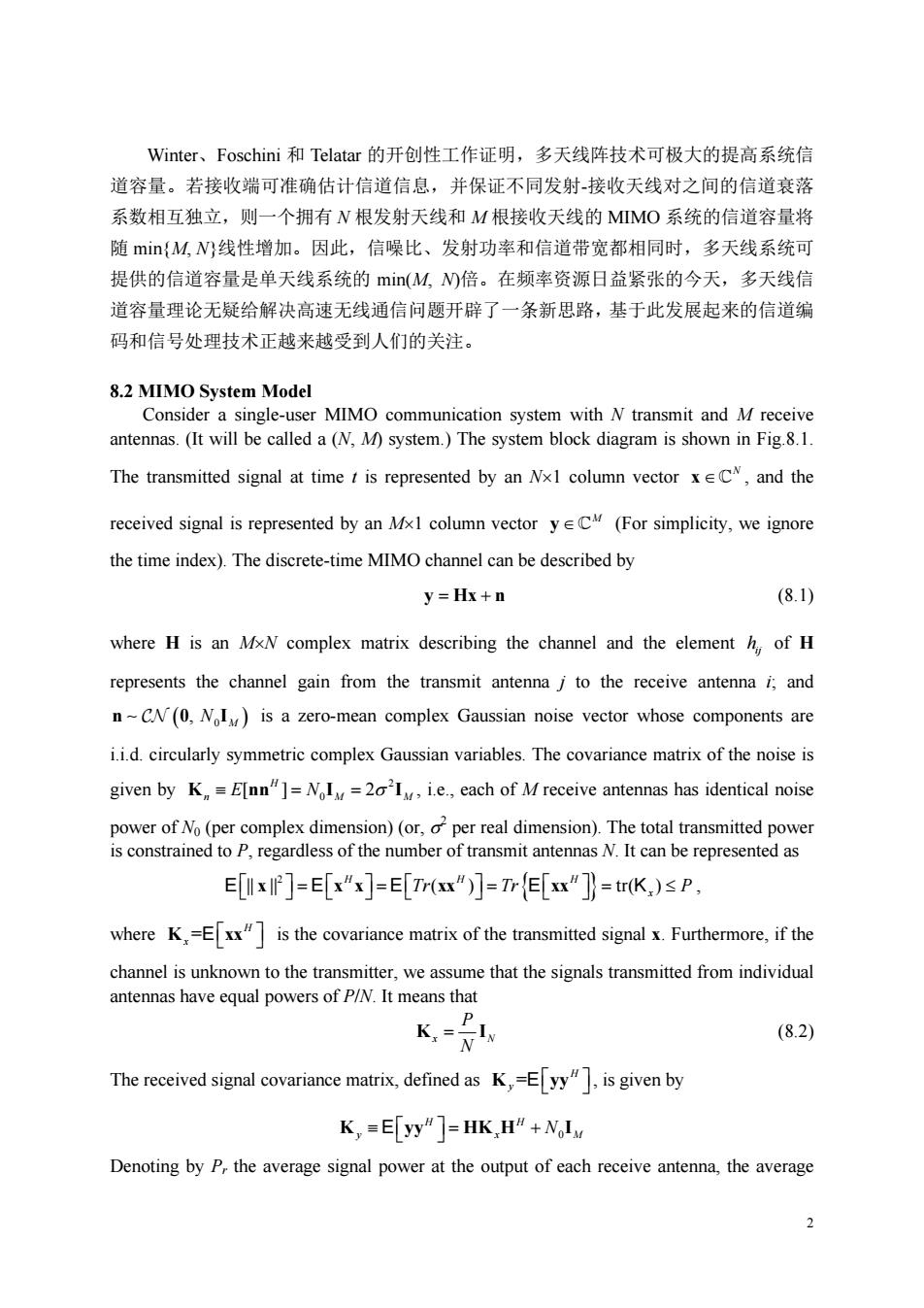正在加载图片...

Winter、Foschini和Telatar的开创性工作证明,多天线阵技术可极大的提高系统信 道容量。若接收端可准确估计信道信息,并保证不同发射接收天线对之间的信道衰落 系数相互独立,则一个拥有N根发射天线和M根接收天线的MMO系统的信道容量将 随mi{MN线性增加。因此,信噪比、发射功率和信道带宽都相同时,多天线系统可 提供的信道容量是单天线系统的mi(M倍。在频率资源日益紧张的今天,多天线信 道容量理论无疑给解决高速无线通信问题开辟了一条新思路,基于此发展起来的信道编 码和信号处理技术正越来越受到人们的关注。 8.2 MIMO System Model nmunication system with N transmit and Mreceive The transmitted signal at time is represented by an Nx1 column vector xeC,and the received signal is represented by an Mx1 column vector yC(For simplicity,we ignore the time index).The discrete-time MIMOchannel can be described by y=Hx+n (8.1) where H is an MxN complex matrix describing the channel and the elementh,of H represents the channel gain from the transmit antenna to the receive antenna and n(0.N)is a zero-mean complex Gaussian noise vector whose components are ii.d.circularly symmetric complex Gaussian variables.The covariance matrix of the noise is given by KEnn]=N=,i.e.,each of Mreceive antennas has identical noise power of No(per complex dimension)(or,per real dimension).The total transmitted power is constrained to P,regardless of the number of transmit antennas N.It can be represented as Ex=E[xx]=E[Tr(x")]=TrEfxx=tr(K)sP. where K=Exxis the covariance matrix of the transmitted signal x.Furthermore,if the channel is unknown to the transmitter,we assume that the signals transmitted from individual antennas have equal powers of P/N.It means that K.= (8.2) The received signal covariance matrix,defined as K,=Eyy,is given by K,=Eyy"=HK,H"+NoI Denoting by P the average signal power at the output of each receive antenna,the average2 Winter、Foschini 和 Telatar 的开创性工作证明,多天线阵技术可极大的提高系统信 道容量。若接收端可准确估计信道信息,并保证不同发射-接收天线对之间的信道衰落 系数相互独立,则一个拥有 N 根发射天线和 M 根接收天线的 MIMO 系统的信道容量将 随 min{M, N}线性增加。因此,信噪比、发射功率和信道带宽都相同时,多天线系统可 提供的信道容量是单天线系统的 min(M, N)倍。在频率资源日益紧张的今天,多天线信 道容量理论无疑给解决高速无线通信问题开辟了一条新思路,基于此发展起来的信道编 码和信号处理技术正越来越受到人们的关注。 8.2 MIMO System Model Consider a single-user MIMO communication system with N transmit and M receive antennas. (It will be called a (N, M) system.) The system block diagram is shown in Fig.8.1. The transmitted signal at time t is represented by an N1 column vector N x , and the received signal is represented by an M1 column vector M y (For simplicity, we ignore the time index). The discrete-time MIMO channel can be described by y Hx n (8.1) where H is an MN complex matrix describing the channel and the element ij h of H represents the channel gain from the transmit antenna j to the receive antenna i; and 0 , n 0I N M is a zero-mean complex Gaussian noise vector whose components are i.i.d. circularly symmetric complex Gaussian variables. The covariance matrix of the noise is given by 2 0 [] 2 H K nn I I n MM E N , i.e., each of M receive antennas has identical noise power of N0 (per complex dimension) (or, 2 per real dimension). The total transmitted power is constrained to P, regardless of the number of transmit antennas N. It can be represented as 2 || || ( ) tr( ) HHH Tr Tr P x E EE E K x x x xx xx , where = H x K xx E is the covariance matrix of the transmitted signal x. Furthermore, if the channel is unknown to the transmitter, we assume that the signals transmitted from individual antennas have equal powers of P/N. It means that x N P N K I (8.2) The received signal covariance matrix, defined as = H y K E yy , is given by 0 H H y xM N K E yy HK H I Denoting by Pr the average signal power at the output of each receive antenna, the average